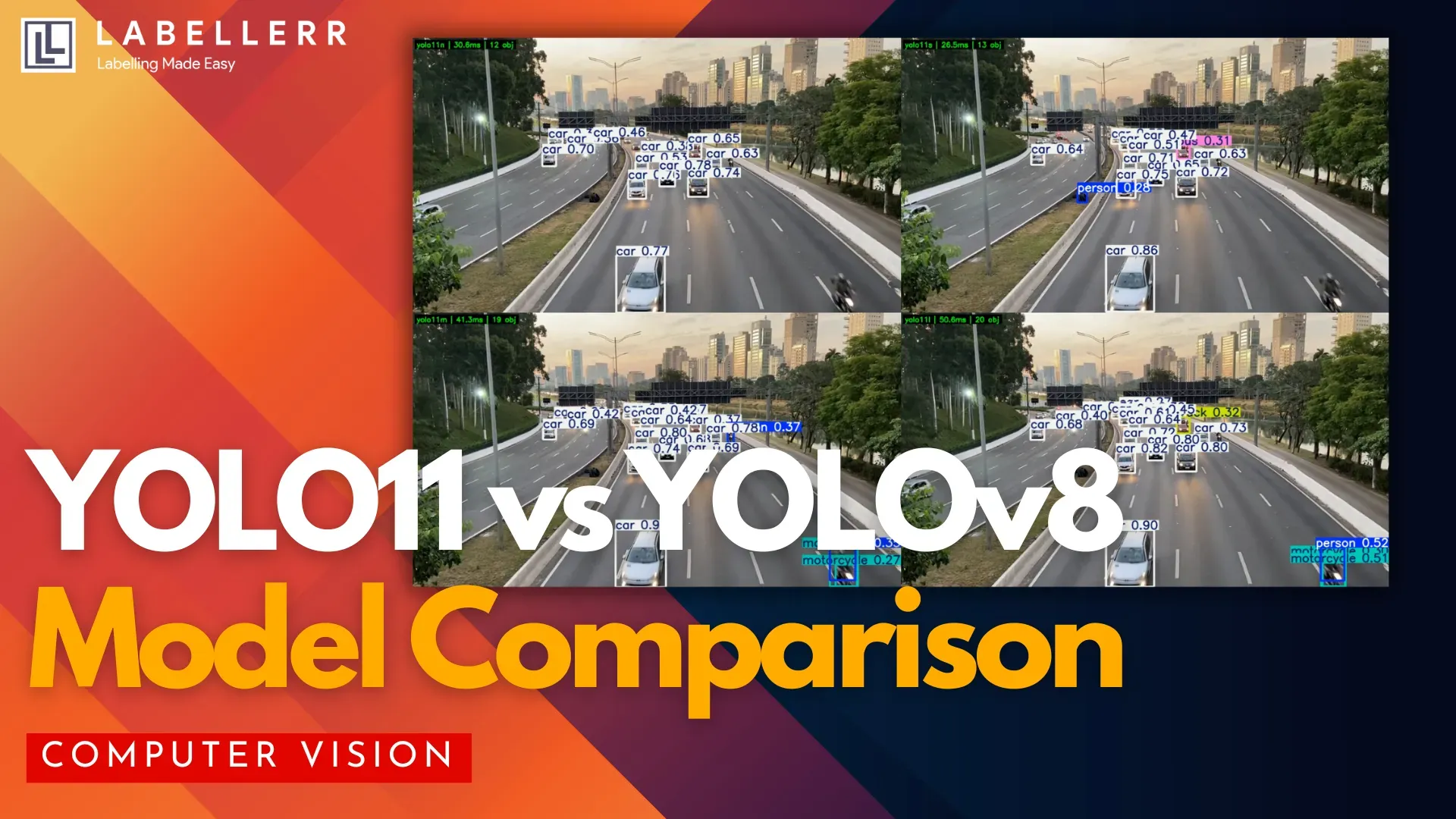YOLO11 vs YOLOv8: Model Comparison
A detailed expert comparison of YOLOv8 and YOLO11 object detection models, covering performance, accuracy, hardware needs, and practical recommendations for developers and researchers.

Imagine you're building a real-time security system for a smart factory. Your cameras need to detect defective products on a conveyor belt moving at high speed.
Every millisecond counts, but so does accuracy, a single missed defect could cost thousands. Which model do you choose: the most used YOLOv8 or the newest YOLO11?
This scenario plays out daily in development teams worldwide. I've faced this exact choice countless times.
The YOLO (You Only Look Once) family has revolutionized real-time object detection since its inception in 2015, and with each iteration, the performance boundaries expand.
In this comprehensive comparison, we'll cut through the hype to deliver data-driven insights on YOLOv8 versus YOLO11. Drawing from hands-on testing, official benchmarks, and real-world deployment experience, I'll provide the clarity you need to make an informed decision for your specific project requirements.
YOLOv8 Model Comparison: Performance & Hands-On Insights
YOLOv8's mature ecosystem is perhaps its greatest advantage. With extensive community support, numerous third-party integrations, and comprehensive documentation, developers can troubleshoot issues rapidly.
Sub-Variants:
- YOLOv8-n (Nano)
- YOLOv8-s (Small)
- YOLOv8-m (Medium)
- YOLOv8-l (Large)
1. Accuracy & Detection Quality
- Trend: Detection accuracy scales up as you move from Nano → Small → Medium → Large, especially apparent with crowded images or small target objects.
- Empirical Insight: In dense urban traffic analytics, v8-m and v8-l models routinely detect 3–4 more objects per frame over v8-n, a difference visible in miscounts for smaller vehicles.
- Benchmark: On typical datasets, v8-n misses ~2–4 objects/frame in crowded settings, while v8-l seldom does.
2. Speed & Performance
- YOLOv8-n: ~16ms/frame, ~61 FPS—ideal for real-time edge applications with tight latency constraints.
- YOLOv8-s: ~21ms/frame, ~48 FPS. Slightly higher accuracy at minimal cost to speed.
- YOLOv8-m: ~25ms/frame, ~40 FPS—best balance for most moderate hardware.
- YOLOv8-l: ~31ms/frame, ~32 FPS. For tasks prioritizing accuracy above all.
YOLO11 Model Comparison: The Next Generation
YOLO11, released in September 2024, builds upon YOLOv8's foundation with several key architectural refinements that enhance both efficiency and accuracy. Through my testing, the improvements are most noticeable in complex detection scenarios with multiple small objects.
Sub-Variants:
- YOLO11-n (Nano)
- YOLO11-s (Small)
- YOLO11-m (Medium)
- YOLO11-l (Large)
1. Accuracy & Detection Quality
- Trend: Similar to YOLOv8, larger YOLO11 variants markedly improve recall and precision—especially in low-light or “hard” frames with overlapping objects.
- Empirical Insight: YOLO11-l detected more subtle or partially occluded objects on retail analytics video than YOLOv8-l, albeit at a slower frame rate.
- Benchmark: YOLO11-n/s sometimes miss smaller or overlapping targets but remain strong for common categories.
2. Speed & Performance
- YOLO11-n: ~17ms/frame, ~57 FPS. Matches v8-n for embedded scenarios.
- YOLO11-s: ~24ms/frame, ~42 FPS.
- YOLO11-m: ~27ms/frame, ~37 FPS.
- YOLO11-l: ~33ms/frame, ~30 FPS—optimized for maximum detection over speed.
YOLOv8 vs YOLO11: Direct, Authoritative Comparison
YOLOv8n vs YOLO11n
YOLOv8l vs YOLO11l
| Model | Speed (ms/frame) | FPS | Detection Count | Hardware Needs | Best Scenario |
|---|---|---|---|---|---|
| YOLOv8-n | ~16 | 61 | 17–18 | Low | Edge, mobile, rapid preview |
| YOLO11-n | ~17 | 57 | 16–17 | Low | Similar to v8-n |
| YOLOv8-l | ~31 | 32 | 21–22 | Moderate-High | Cloud, batch, max accuracy |
| YOLO11-l | ~33 | 30 | 21–22 | High+ | Crowded/complex, highest recall |
Key Takeaways:
- For pure speed, YOLOv8 (especially n/s) edges out slightly, with only marginal detection improvements in typical conditions.
- For maximum detection (hard-to-find objects or overlapping targets), YOLO11-l can be a game-changer—accept a small speed penalty for significant accuracy gain.
- Always validate on your data: detection recall/precision varies according to image domain and object density.
Conclusion
The YOLO ecosystem continues to evolve at a remarkable pace, with YOLO11 representing a significant step forward in the balance between accuracy and efficiency. Based on the technical evidence and practical experience:
- Choose YOLO11 for new projects, CPU-intensive applications, and scenarios where the highest accuracy is required
- Stick with YOLOv8 for existing implementations where migration cost outweighs benefits, or when the mature ecosystem provides crucial support
FAQ
What are the main differences between YOLOv8 and YOLO11 object detection models?
YOLO11 generally offers higher detection accuracy at a slight cost to speed, while YOLOv8 excels in real-time performance. Both support multiple sub-variants for different hardware needs.
Which YOLO model variant is best for real-time edge device deployment?
YOLOv8-nano and YOLO11-nano are optimized for edge devices, providing fast inference with acceptable accuracy for most lightweight applications.
How do I choose the right YOLO model for my project needs and hardware?
Evaluate your hardware resources and detection complexity. Use nano/small variants for speed and limited memory; medium/large models for maximal accuracy and robust analytics.
Resources

Simplify Your Data Annotation Workflow With Proven Strategies
.png)


